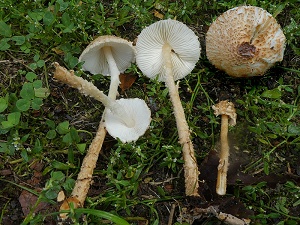| Lepiota ochraceofulva P.D. Orton |
|
|
|
|
|
|
The cap is tawny to reddish brown on an ochre-yellow background. The cap surface is scaly, not viscid nor sticky. The stem is smooth, with a short-lived ring. The flesh is turning yellow when exposed to air; its taste is mild, not distinctive; the odour is pleasant; its texture is fibrous. The gills are adnate, crowded . The spore print is white. This species is saprophytic. It grows on the ground, in the woods. The fruiting period takes place from May to November.
Chemical tests : none. Distinctive features : turns yellow when touched Lepiota ochraceofulva is still unreported so far in the forest of Rambouillet, and is infrequent, more generally speaking .
page updated on 14/01/18 |
